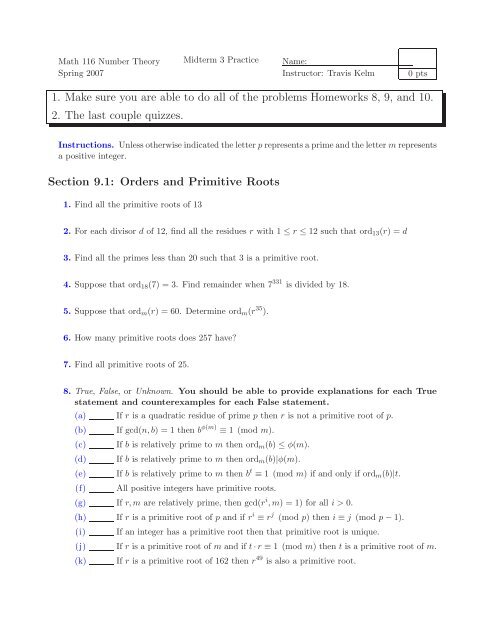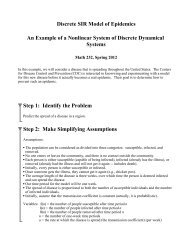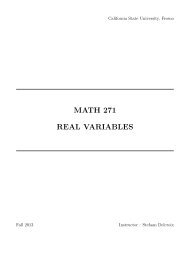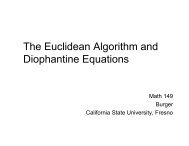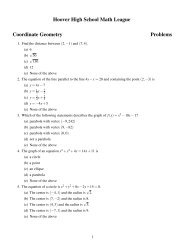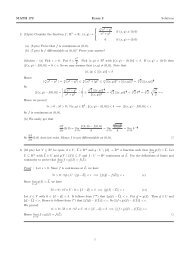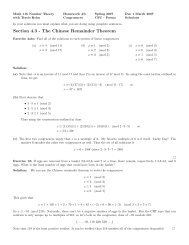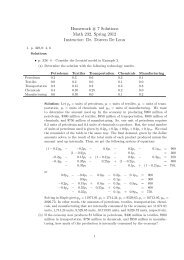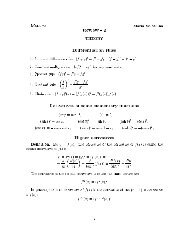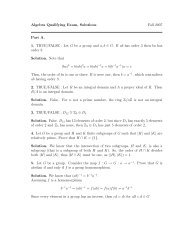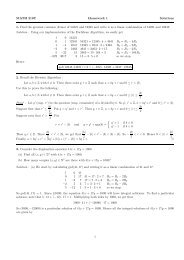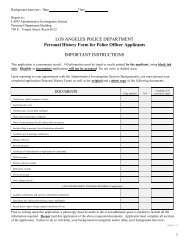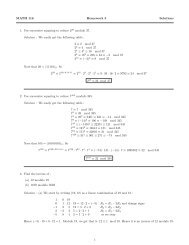1. Make sure you are able to do all of the problems Homeworks 8, 9 ...
1. Make sure you are able to do all of the problems Homeworks 8, 9 ...
1. Make sure you are able to do all of the problems Homeworks 8, 9 ...
You also want an ePaper? Increase the reach of your titles
YUMPU automatically turns print PDFs into web optimized ePapers that Google loves.
Math 116 Number Theory<br />
Spring 2007<br />
Midterm 3 Practice<br />
Name:<br />
Instruc<strong>to</strong>r: Travis Kelm<br />
0 pts<br />
<strong>1.</strong> <strong>Make</strong> <strong>sure</strong> <strong>you</strong> <strong>are</strong> <strong>able</strong> <strong>to</strong> <strong>do</strong> <strong>all</strong> <strong>of</strong> <strong>the</strong> <strong>problems</strong> <strong>Homeworks</strong> 8, 9, and 10.<br />
2. The last couple quizzes.<br />
Instructions. Unless o<strong>the</strong>rwise indicated <strong>the</strong> letter p represents a prime and <strong>the</strong> letter m represents<br />
a positive integer.<br />
Section 9.1: Orders and Primitive Roots<br />
<strong>1.</strong> Find <strong>all</strong> <strong>the</strong> primitive roots <strong>of</strong> 13<br />
2. For each divisor d <strong>of</strong> 12, find <strong>all</strong> <strong>the</strong> residues r with 1 ≤ r ≤ 12 such that ord 13 (r) = d<br />
3. Find <strong>all</strong> <strong>the</strong> primes less than 20 such that 3 is a primitive root.<br />
4. Suppose that ord 18 (7) = 3. Find remainder when 7 331 is divided by 18.<br />
5. Suppose that ord m (r) = 60. Determine ord m (r 35 ).<br />
6. How many primitive roots <strong>do</strong>es 257 have<br />
7. Find <strong>all</strong> primitive roots <strong>of</strong> 25.<br />
8. True, False, or Unknown. You should be <strong>able</strong> <strong>to</strong> provide explanations for each True<br />
statement and counterexamples for each False statement.<br />
(a) If r is a quadratic residue <strong>of</strong> prime p <strong>the</strong>n r is not a primitive root <strong>of</strong> p.<br />
(b)<br />
(c)<br />
(d)<br />
(e)<br />
(f)<br />
If gcd(n,b) = 1 <strong>the</strong>n b φ(m) ≡ 1 (mod m).<br />
If b is relatively prime <strong>to</strong> m <strong>the</strong>n ord m (b) ≤ φ(m).<br />
If b is relatively prime <strong>to</strong> m <strong>the</strong>n ord m (b)|φ(m).<br />
If b is relatively prime <strong>to</strong> m <strong>the</strong>n b t ≡ 1 (mod m) if and only if ord m (b)|t.<br />
All positive integers have primitive roots.<br />
(g) If r,m <strong>are</strong> relatively prime, <strong>the</strong>n gcd(r i ,m) = 1) for <strong>all</strong> i > 0.<br />
(h) If r is a primitive root <strong>of</strong> p and if r i ≡ r j (mod p) <strong>the</strong>n i ≡ j (mod p − 1).<br />
(i)<br />
If an integer has a primitive root <strong>the</strong>n that primitive root is unique.<br />
(j) If r is a primitive root <strong>of</strong> m and if t · r ≡ 1 (mod m) <strong>the</strong>n t is a primitive root <strong>of</strong> m.<br />
(k)<br />
If r is a primitive root <strong>of</strong> 162 <strong>the</strong>n r 49 is also a primitive root.
Math 116 Number Theory/MT 3 - Practice – Page 2 <strong>of</strong> 3 – Name:<br />
Section 9.2: Primitive Roots<br />
9. (a) If gcd(b,257) = 1 <strong>the</strong>n what <strong>are</strong> <strong>the</strong> possible values <strong>of</strong> ord257 (b)<br />
(b) How many residue classes <strong>of</strong> 257 have order 16 How many have order 25 How many<br />
have order 64<br />
10. True, False, or Unknown. You should be <strong>able</strong> <strong>to</strong> provide explanations for each True<br />
statement and counterexamples for each False statement.<br />
(a) If p is odd prime and r is a primitive root <strong>of</strong> p, <strong>the</strong>n r 2 is a primitive root <strong>of</strong> p 2 .<br />
(b) If p is an odd prime and if r is a primitive root <strong>of</strong> p 2 <strong>the</strong>n r is a primitive root <strong>of</strong> p 6<br />
Section 9.4: Index Arithmetic<br />
1<strong>1.</strong> Complete <strong>the</strong> following t<strong>able</strong>:<br />
n 1 2 3 4 5 6 7 8 9 10 11 12<br />
ind 2 (n)<br />
12. Find <strong>all</strong> <strong>the</strong> solutions <strong>to</strong> 4x 11 ≡ 9 (mod 13).<br />
13. Find <strong>all</strong> <strong>the</strong> solutions <strong>to</strong> 2x 9 ≡ 11 (mod 13).<br />
14. Find <strong>all</strong> <strong>the</strong> solutions <strong>to</strong> x x ≡ 6 (mod 13).<br />
15. True, False, or Unknown. You should be <strong>able</strong> <strong>to</strong> provide explanations for each True<br />
statement and counterexamples for each False statement.<br />
(a)<br />
If r is a solution <strong>to</strong> 2 x ≡ 89 (mod 101) <strong>the</strong>n r + 100 is also a solution.
Math 116 Number Theory/MT 3 - Practice – Page 3 <strong>of</strong> 3 – Name:<br />
Section 9.5: Primality Tests<br />
16. List <strong>all</strong> known Fermat Primes.<br />
17. Which <strong>of</strong> <strong>the</strong> following regular n-gons <strong>are</strong> constructible using only a compass and straightedge<br />
(a) 14-gon<br />
(b) 25-gon<br />
(c) 30-gon<br />
(d) 34-gon<br />
(e) 771-gon<br />
18. Find <strong>all</strong> <strong>the</strong> solutions <strong>to</strong> 2x 9 ≡ 11 (mod 13).<br />
19. Find <strong>all</strong> <strong>the</strong> solutions <strong>to</strong> x x ≡ 6 (mod 13).<br />
Chapter 11: Quadratic Reciprocity<br />
20. True, False, or Unknown. You should be <strong>able</strong> <strong>to</strong> provide explanations for each True<br />
statement and counterexamples for each False statement.<br />
(a) If m,b <strong>are</strong> any integers, <strong>the</strong>n b 2 ≡ (m − b) 2 (mod m).<br />
(b) If m > 0 <strong>the</strong>re <strong>are</strong> m − 1 quadratic residues modulo m.<br />
2<br />
(c) x 2 ≡ 75 (mod 97) has two incongruent solutions modulo 97.<br />
(d)<br />
(e)<br />
(f)<br />
(g)<br />
(h)<br />
(i)<br />
x 2 ≡ −1 (mod 257) has no solutions.<br />
If p ̸ |a <strong>the</strong>n a p−1<br />
2 ≡ ±1 (mod p).<br />
x 2 ≡ 85 (mod 101) has no solutions.<br />
x 2 ≡ 29 (mod 541) has no solutions.<br />
x 2 ≡ 101 (mod 1987) has no solutions.<br />
x 2 ≡ 31706 (mod 43789) has no solutions.<br />
2<strong>1.</strong> Be <strong>able</strong> <strong>to</strong> compute Legendre and Jacobi symbols.


